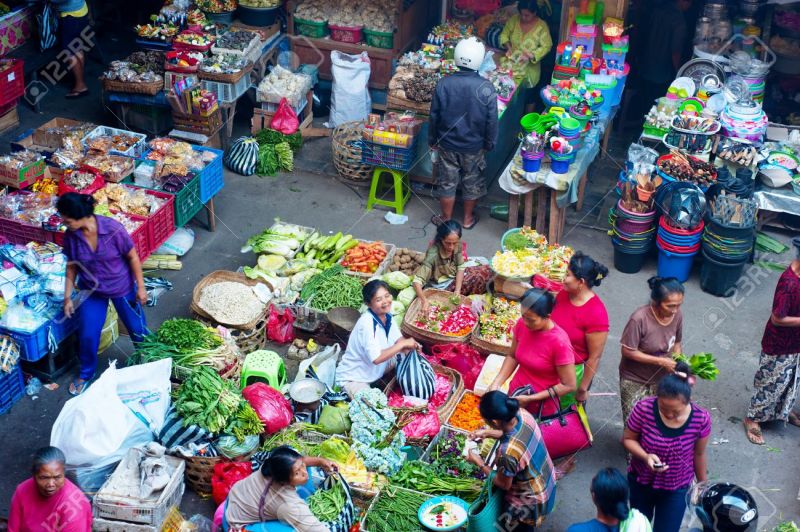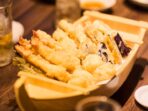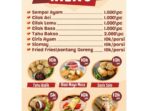Indonesia Food Market – We use cookies to make your experience better. According to the new e-affirmation order, you need to request approval to set cookies. learn more.
In 2016, the Indonesian comfort food market was estimated at USD 11.45 billion (in retail price). From 2016 to 2020, it grew 4.64% at a combined annual growth rate (CAGR) to $13.73 billion. The market is divided into food, soup and soup. By 2020, 46% and 54% of the shares were registered in each section respectively.
Indonesia Food Market

In 2016, Indonesian comfort food consumption was US$43.78 (at retail price). Until 2020, consumption increased to a compound annual growth rate of 3.48%, reaching USD 50.20. It is smaller than the average value of the Asia-Pacific region, and by 2020, its comfort food alone equals $52.65.
7 Ramadan Market In Indonesia To Hunt Typical “takjil”
The market research report proposes a strategic analysis of the market and its forecast for growth in the medium term. The study provides a comprehensive view of the market:
The report provides socio-economic data and product breakdowns in the region, which provides a broad view of market mechanics in a region.
The market research report was prepared through Williams and Marshal’s strategy approach. A combination of quality and quantity of data from official sources. All studies were examined by intelligence collected in semi-structured interviews with market experts. They are representatives of major market players – manufacturers, distributors, wholesalers and retailers.
The report will be released within five business days of confirmation of the order. If you need fast delivery times, please contact us for possibilities.
Indonesia Foodservice Market Size & Share Analysis
This research report allows you to quickly conduct strategic analysis of your target market. You will get historical and predictive data on market size, value, division, forecast, dynamics and structure.
You can customize your reports based on your specific requirements and requirements. We also offer research and consulting services that provide tailoring solutions that fit your unique insights needs. Managing food safety in traditional food markets: Five keys to improving pilot hygiene and health standards
From August 2023 to October 2023, the World Health Organization (WHO) supports three provinces in Indonesia. The focus is on raising health and wellness standards and protecting the health and wellness of consumers and market workers.

Throughout Indonesia, 16,000 traditional food markets are the main source of new food and are also products from the surrounding communities. In the 2020 census, the Indonesian Ministry of Health (MOH) found that over 10% of the 448 traditional food markets in 28 provinces were diagnosed with health and wellness standards. It increases the spread of dietary diseases as well as the exposure and spread of juvenile diseases.
Hungry For Change: Meet The Indonesian Youth Reforming Our Food Systems
To address this issue, based on the five keys to the Safe Traditional Food Market, the Semarang and Bandung areas contribute to the design and implementation of a pilot project at three main locations in the city of Saminda. Five keys provide risk-reducing measures and strategies to improve risk communication and social participation. They are designed to benefit the entire market community, including management, employees and civilians, and face environmental challenges.
Using the evaluation tool developed by MOH, planners first conducted a detailed analysis of the market conditions. The results show conclusions such as the lack of information on food safety and health posters, as well as water quality, lack of documentary cleaning protocols, insufficient insect control and no protocols for handling direct animals. Although knowledge, attitudes, and procedures (KAP) are accompanied by elements of the method, many misconducts are common, i.e., it is believed that hands are washed with water only.
Based on these inventions, consult with senior state shareholders – various information, education and communication materials are consulted through shareholder practice, discussion with each other, market notifications and social media sites. Next is the ongoing intervention of KAP research and conferences, which has made significant progress in implementing health and wellness standards everywhere.
Interactive information, educational and communication materials have been developed to convert knowledge through social media sites and flyers. improve:
Indonesian Food Market Photos And Images & Pictures
“From this activity, there are many stages to wash your hands and I know I need enough time to kill the bacteria,” said Ibu Nurul Uwfiq, a meat salesman at Karangjati Market in Semalang District. In three locations, sellers’ knowledge of major health measures increased from 84% before the intervention to 90%, and now 80% of sellers have cleaned the kiosks and site with water, soap or disinfectant, just 70% before.
Based on the success of the five key projects, the value of target interventions raises awareness, changes behavior and promotes collaboration between local authorities, market shareholders and the wider community.
“The health market is a health market, the center for promoting welfare, the center for developing a circular economy, where health welfare and community prosperity are uncontrollable.” Bandung District. “We set up basic standards in market design by implementing five keys, which not only reduces health risks, but also prevents the spread of juvenile disease.”

In the next month, the current capacity of the market community will support the development of the commerce and industry, which will continue to work in the Trade and Industry Department and help the same use of food security protocols throughout Indonesia, which will continue to participate in healthy and safe traditional food markets. , Five key methods for coordinating MOH in Sni Pasar Raghiyat. Government – In 1920, Indonesia’s food and drinking sector grew by 3% (Denzitteries, 2020). From 2021 to 2026, the annual growth rate is expected to reach USD 2021, at USD 517 million, accounting for 10.8% of the annual growth rate. The industry is expected to reach $3724 million in 2025 (statistics, 2021). Therefore, the industry provides huge investment opportunities.
The Best Indonesian Food In Jakarta (updated 2025)
Earlier, we discussed the beverage industry in Indonesia. In this article, we will cover up the landscape of Indonesia’s food industry and its opportunities. Many parts contribute to the Indonesian food industry and we will discuss agriculture, food processing and food distribution. In addition, we also analyze the impact of the government, how to enter the market, and a wide understanding of the Indonesian food industry.
Agriculture is an important part of Indonesia’s food industry. The country has 57 million hectares of agricultural land, which transforms agriculture into one of Indonesia’s main sectors, which accounted for 12.72% of GDP in 2019 (World Bank, 2019). Domestic and foreign investment in the Indonesian agricultural sector is concentrated on 94.47% of plantation sub-sector accounts, followed by 3.71% of livestock sub-sector and 0.57% of food crops (FTT, 2020).
The GDP from Indonesia’s food crops was IDR 446 trillion in 2019. The country’s major food crops include rice, corn, soybeans, cassawa and sweet potatoes. Small industries are dominated by Indonesia’s rice production (90% of the country’s rice production), with each farmer having about 0.8 hectares of land (Indonesia Ministry of Agriculture, 2016). Meanwhile, sweet potatoes, mubia, peanuts and soybeans are usually planted after rice is grown.
The main vegetables grown in Indonesia are mushrooms, cabbage, chili, potatoes, onions and tomatoes. Meanwhile, Indonesia’s highest fruit produces bananas, Massachusetts, citrus, papaya, durian, pineapple, apple, snake fruit, jagfrud and rambutan (Stats Indonesia, 2016).
President Signs Regulation On Government Food Reserves
In 2017, Indonesia’s livestock and its products were US$1485 trillion in the country’s GDP, with an average growth from 2013 to 2017 (Indonesia, Indonesia). Livestock and poultry respond significantly to the country’s growing food demand.
The livestock industry in Indonesia has experienced a gap between supply and demand for beef, with only 45% of Indonesians meeting meat needs (Agus and Vadi, 2018). In 2017, Indonesia’s meat production reached 532,000 tons, with the majority of the Java livestock population housing and livestock massacres (Corporate Livestock Services and Animal Health, 2018).
The goat sector in Indonesia is still underestimated due to small production. In 2018, goat production reached 18.72 million, focusing on half of the goat population. According to the Asian Center for Food and Fertilizer Technology, there is an increasing demand for goat meat and milk, usually during the months of Eid and Ramadan. Meanwhile, the production of lamb meat in 2017 was 55 million tons (PKPM, 2018).

Although most Indonesians are Muslims, the country’s pork industry is increasing demand for 32.5 million non-Mexicans. In 2017, pork production was 344 million tons, focusing on Eastern Nusa Tengara (Corporate Livestock Services and Animal Health, General, 2018).
Ubud, Bali Island, Indonesia
Indonesia’s poultry industry includes its own chicken and broiler industries. In 2017, there were about 1.5 billion local chickens
Indonesia wholesale market, indonesia market overview, market indonesia, food indonesia, indonesia furniture market, bali indonesia food, indonesia housing market, market research indonesia, bali indonesia market, indonesia market index, stock market indonesia, food truck indonesia






